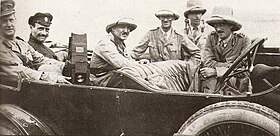Dunsterforce
| Dunsterforce | |
|---|---|
 Dunsterville (far left) with staff | |
| Active | 1917 - 1919 |
| Country | Britain, Commonwealth |
| Allegiance | Allies |
| Type | Infantry |
| Role | Detachment |
| Size | Brigade |
| Engagements | Battle of Baku |
| Commanders | |
| Notable commanders | Lionel Dunsterville, Ranald MacDonell |
Established in 1917, Dunsterforce was an Allied military mission of under 1,000 Australian, British, Canadian and New Zealand elite troops (drawn from the Mesopotamian and Western Fronts), accompanied by armoured cars, deployed from Hamadan some 350 km across Qajar Persia. It was named after its commander General Lionel Dunsterville. Its mission was to try and prevent a (somewhat unlikely) invasion of India by Germany and the Ottoman Empire. It was initially delayed by 3,000 Russian Bolshevik troops at Enzeli but then proceeded by ship to the port of Baku on the Caspian Sea. This was the primary target for the advancing Turkish forces and Dunsterforce endured a short, brutal siege in September 1918 before being forced to withdraw.
Order of battle
The British element of Dunsterforce comprised 39th Brigade of 13th (Western) Division. On July 1 1918 the brigade received orders to be detached from the division for attachment to the North Persia Force. The brigade's component units left the division between July 10 and August 19 . Brigade HQ arrived in Baku at Dunsterforce HQ on August 24.
- 39th Brigade
- 9th (Service) Battalion, The Royal Warwickshire Regiment
- 7th (Service) Battalion, The Gloucestershire Regiment
- 9th (Service) Battalion, The Worcestershire Regiment
- 7th (Service) Battalion, The North Staffordshire Regiment
- 39th Machine Gun Company, Machine Gun Corps (MGC)
- 39th Supply & Transport Column, Army Service Corps (ASC)
- 39th Trench Mortar Battery
Soviet account
Soviet archivist Vasili Mitrokhin claimed that Dunsterforce's objective was, under the guise of defending British India, to secure a foothold in the Caucasus. The force would then co-operate with counter-revolutionary forces to overthrow the Baku Soviet and seize control of the whole of the oil-rich Caucasus, the Caspian Sea, and all surrounding regions. Mitrokhin claimed that Gen. Dunsterville had "forty Ford vans loaded with gold and silver" to pay for the operation.
